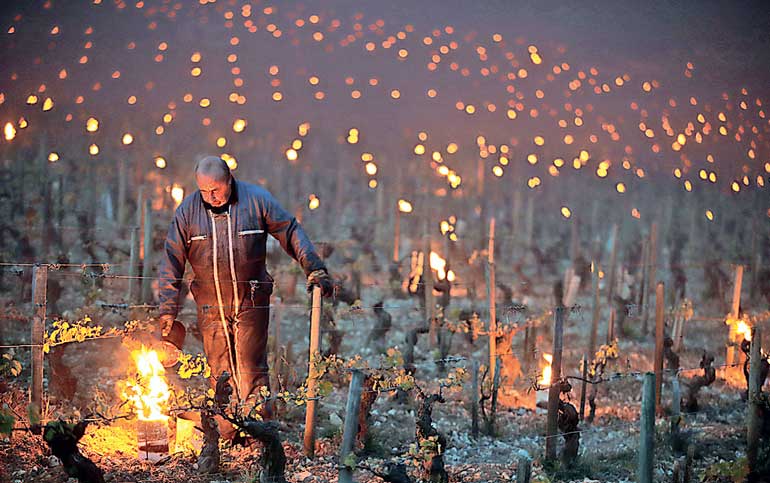Tuesday Apr 22, 2025
Tuesday Apr 22, 2025
Tuesday, 2 May 2017 00:00 - - {{hitsCtrl.values.hits}}
 Workers and wine growers light heaters early in the morning, to protect vineyards from frost damage outside Chablis, France April 28, 2017 – REUTERS
Workers and wine growers light heaters early in the morning, to protect vineyards from frost damage outside Chablis, France April 28, 2017 – REUTERS
AFP: Making wine is a tough job in most places, what with frost, hail, drought and bushfires to contend with.
But nowhere is the task bigger than in Argentina’s Mendoza region, where vintners duel “the whole gamut of natural hazards” – not least frequent earthquakes, according to research unveiled on Wednesday.
The region tops a new index of wine areas most targeted by Nature’s wrath.
“We see that Mendoza in Argentina, which has earthquakes, hail, floods, the whole gamut of natural hazards... is number one,” said James Daniell of the Karlsruhe Institute of Technology in Germany, who helped compile the new data.
Second and third were Georgia and Moldova, “countries that obviously have smaller GDPs but the percentage of their GDP due to wine is very, very high,” he said.
Northwestern Slovenia came in at number four, while Ecuador’s Yaruqui Valley and Nagano in Japan shared fifth place on the Global Wine Risk Index.
It was compiled by a team of geophysicists, geoscientists, meteorologists and economists using data on wine industry losses due to natural hazards going back to 1900.
The atlas covers 110,000 wineries in 131 countries producing about 26 billion litres every year, said Daniell, who presented the results at a meeting of the European Geosciences Union in Vienna.
The industry is estimated to directly contribute $300 billion (275 billion euros) to the world economy annually.
But “it’s a highly vulnerable industry,” said Daniell – with about 10 percent of wine production lost to natural hazards every year at an estimated loss of $10 billion.
Over five years up to 2016, hail costs winemakers in France’s famous Burgundy region as much as 50 percent of their crops, according to the research.
In 2010, Chile lost 125 million litres of wine to a monster quake.
Just last week, Switzerland, Austria, Germany and Hungary suffered frost that could claim 30 percent – up to 60 percent in some parts – of crops.
It is hoped the new resource will help winegrowers be better prepared, learning from past trends. It makes no future projections.
If an area had had no hail for a few years in a row, for example, winemakers could use the historic data to calculate whether this was likely to be a mere blip in a region generally at elevated hail risk.
“This uses data going back from 1900 onwards. They can at least identify that they are at risk and... do something about it to mitigate it,” said Daniel.
Measures could include covering valuable crops with anti-hail nets, tying up wine bottles to withstand the shock of an earthquake, using a “hail cannon”, as Burgundy is doing, to seed clouds with stone-shrinking silver iodine, or taking out crop insurance.
The index will be updated annually, and made accessible via www.winerisk.org.
Discover Kapruka, the leading online shopping platform in Sri Lanka, where you can conveniently send Gifts and Flowers to your loved ones for any event including Valentine ’s Day. Explore a wide range of popular Shopping Categories on Kapruka, including Toys, Groceries, Electronics, Birthday Cakes, Fruits, Chocolates, Flower Bouquets, Clothing, Watches, Lingerie, Gift Sets and Jewellery. Also if you’re interested in selling with Kapruka, Partner Central by Kapruka is the best solution to start with. Moreover, through Kapruka Global Shop, you can also enjoy the convenience of purchasing products from renowned platforms like Amazon and eBay and have them delivered to Sri Lanka.
Discover Kapruka, the leading online shopping platform in Sri Lanka, where you can conveniently send Gifts and Flowers to your loved ones for any event including Valentine ’s Day. Explore a wide range of popular Shopping Categories on Kapruka, including Toys, Groceries, Electronics, Birthday Cakes, Fruits, Chocolates, Flower Bouquets, Clothing, Watches, Lingerie, Gift Sets and Jewellery. Also if you’re interested in selling with Kapruka, Partner Central by Kapruka is the best solution to start with. Moreover, through Kapruka Global Shop, you can also enjoy the convenience of purchasing products from renowned platforms like Amazon and eBay and have them delivered to Sri Lanka.